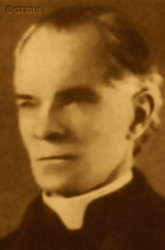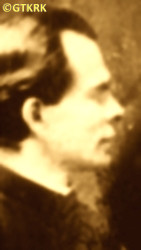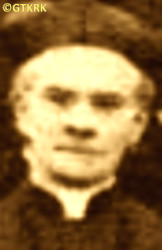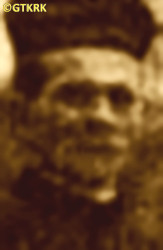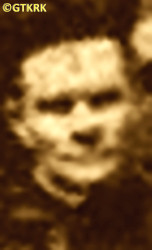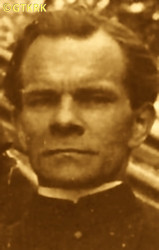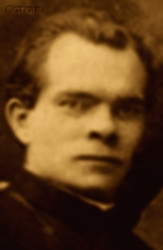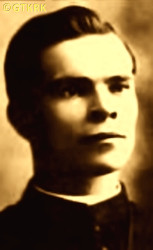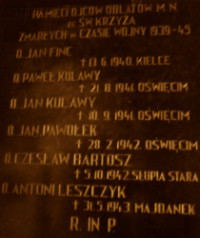Roman Catholic
St Sigismund parish
05-507 Słomczyn
85 Wiślana Str.
Konstancin deanery
Warsaw archdiocese, Poland
full list:
displayClick to display full list

searchClick to search full list by categories
wyświetlKliknij by wyświetlić pełną listę po polsku

szukajKliknij by przeszukać listę wg kategorii po polsku

Martyrology of the clergy — Poland
XX century (1914 – 1989)
personal data
surname
KULAWY
forename(s)
John William (pl. Jan Wilhelm)
function
religious cleric
creed
Latin (Roman Catholic) Church RCmore on
en.wikipedia.org
[access: 2014.09.21]
congregation
Congregation of Missionary Oblates of Mary Immaculate OMImore on
en.wikipedia.org
[access: 2013.05.19]
(i.e. Oblates)
diocese / province
Polish province OMI
Pinsk diocesemore on
en.wikipedia.org
[access: 2013.05.19]
Polish provincial vicariate (vice‐province) OMI
German province OMI
St Boniface vicariate (later: Manitoba province)
northern France province OMI
academic distinctions
Bachelor of Sacred Theology
date and place
of death
10.09.1941

KL Auschwitzconcentration camp
today: Oświęcim, Oświęcim gm., Oświęcim pov., Lesser Poland voiv., Poland
more on
en.wikipedia.org
[access: 2022.01.09]
alt. dates and places
of death
21.09.1941
details of death
During his stay in Piekary Śląskie in 1919‐1920, participated in Polish preparations for the plebiscite to decide the nationality of Upper Silesia (the plebiscite took place a year later).
After German and Russian invasion of Poland in 09.1939 and start of World War II, after start of the German occupation, arrested by the Germans on 30.04.1940.
Tortured.
Released after 8 days.
Arrested again by the Germans on 09.07.1941 during interrogation (day earlier received summons to a police station in Kielce), together with his brother, Fr Paul Kulawy, among others.
Jailed in Kielce prison.
From there on 30.07.1941 transported to — arrested were seen at the Kielce railway station, kneeling on the platform with their hands tied with wire, waiting for the train — KL Auschwitz concentration camp where perished: in the camp hospital.
prisoner camp's numbers
19060Click to display source page (KL AuschwitzClick to display the description)
cause of death
extermination: exhaustion and starvation
perpetrators
Germans
sites and events
KL AuschwitzClick to display the description, Regierungsbezirk KattowitzClick to display the description, KielceClick to display the description, GeneralgouvernementClick to display the description, «Intelligenzaktion»Click to display the description, Ribbentrop‐MolotovClick to display the description, Pius XI's encyclicalsClick to display the description, Silesian UprisingsClick to display the description
date and place
of birth
15.05.1872

Leśnicatoday: Leśnica gm., Strzelce Opolskie pov., Opole voiv., Poland
more on
en.wikipedia.org
[access: 2021.08.12]
religious vows
15.08.1893 (temporary)
15.08.1894 (permanent)
presbyter (holy orders)
ordination
04.06.1898

Ottawatoday: Ontario prov., Canada
more on
en.wikipedia.org
[access: 2022.08.05]
positions held
1936 – 1940
friar — Słupia Nowatoday: Nowa Słupia, Nowa Słupia gm., Kielce pov., Holy Cross voiv., Poland
more on
en.wikipedia.org
[access: 2021.09.29] ⋄ Congregation's house (Holy Cross, on Łysa Góra (Eng. Bald Mountain)), Oblates OMI — people's missionary; also: 1. assistant of the Congregation's house (from 1937), missions in northern France (1937), temporary superior of the Congregation's house and prison chaplain (1936)
1934 – 1936
friar — Poznańtoday: Poznań city pov., Greater Poland voiv., Poland
more on
en.wikipedia.org
[access: 2021.07.18] ⋄ Christ the King Congregation's house, Oblates OMI — people's missionary; also: missions in northern France (1934)
1933 – c. 1934
director — Liubeshivtoday: Liubeshiv hrom., Kamin‐Kashyrskyi rai., Volyn obl., Ukraine
more on
en.wikipedia.org
[access: 2022.11.12] ⋄ retired priests' house, Oblates OMI ⋄ Pinsk RC diocese
1931 – c. 1933
friar — Kodeńtoday: Kodeń gm., Biała Podlaska pov., Lublin voiv., Poland
more on
en.wikipedia.org
[access: 2021.09.02] ⋄ Congregation's house, Oblates OMI
1927 – 1931
friar — Poznańtoday: Poznań city pov., Greater Poland voiv., Poland
more on
en.wikipedia.org
[access: 2021.07.18] ⋄ Christ the King Congregation's house, Oblates OMI — also: missions in northern France (1929)
1925 – 1927
friar — Chumiętkitoday: Krobia gm., Gostyń pov., Greater Poland voiv., Poland
more on
en.wikipedia.org
[access: 2022.11.20] ⋄ St John Cantius the Confessor Congregation's house („Krobia”), Oblates OMI
from 1925
first consultant/councillor and admonitor/advisor to the Provincial — Polish Province, Oblates OMI
1922 – 1925
superior — Lubliniectoday: Lubliniec urban gm., Lubliniec pov., Silesia voiv., Poland
more on
en.wikipedia.org
[access: 2021.04.02] ⋄ St Stanislav Kostka the Confessor Congregation's house, Oblates OMI — also: missions in Canada and the USA (1924); one of the main goals was to raise funds for the also: and development of the juniorate in Lubliniec
1922 – 1925
first consultant/councillor and admonitor/advisor to the superior — Polish provincial vicariate (vice–province), Oblates OMI
1921 – 1922
superior — Krotoszyntoday: Krotoszyn gm., Krotoszyn pov., Greater Poland voiv., Poland
more on
en.wikipedia.org
[access: 2021.07.18] ⋄ Congregation's house, Oblates OMI — also: lecturer of Greek in Minor Theological Seminary i.e. Juniorate (equiv. to gymnasium)
1920 – 1921
teacher — Krotoszyntoday: Krotoszyn gm., Krotoszyn pov., Greater Poland voiv., Poland
more on
en.wikipedia.org
[access: 2021.07.18] ⋄ Minor Theological Seminary i.e. Juniorate (equiv. to gymnasium), Congregation's house, Oblates OMI — lecturer of Greek
1919 – 1920
friar — Piekary Wielkiealso: German Piekary
today: Piekary Śląskie, Piekary Śląskie city pov., Silesia voiv., Poland
more on
en.wikipedia.org
[access: 2021.04.02] ⋄ Congregation's house, Oblates OMI
1917 – 1919
friar — Höntroptoday: district of Bochum, Bochum urban dist., North Rhine‐Westphalia state, Germany
more on
de.wikipedia.org
[access: 2022.11.20] ⋄ Missionhouse, Oblates OMI
1906 – 1917
friar — Kapellentoday: district of Grevenbroich, Rhein‐Kreis Neuss dist., Düsseldorf reg., Rhineland‐Palatinate state, Germany
more on
de.wikipedia.org
[access: 2022.11.20] ⋄ St Nicholas Congregation's house (Germ. Nikolauskloster), Oblates OMI — chaplain to the Polish emigrantsin the Rhineland and Westphalia
1906
friar — Arnhemtoday: Gelderland prov., Niederlands
more on
en.wikipedia.org
[access: 2022.08.05] ⋄ Congregation's house, Oblates OMI
1904 – 1906
friar — Kapellentoday: district of Grevenbroich, Rhein‐Kreis Neuss dist., Düsseldorf reg., Rhineland‐Palatinate state, Germany
more on
de.wikipedia.org
[access: 2022.11.20] ⋄ St Nicholas Congregation's house (Germ. Nikolauskloster), Oblates OMI — chaplain to the Polish emigrantsin the Rhineland and Westphalia
1900 – 1904
superior of the Congregation's house and parish priest — Winnipegtoday: Winniped city reg., Manitoba prov., Canada
more on
en.wikipedia.org
[access: 2022.11.20] ⋄ Congregation's house, Oblates OMI ⋄ Holy Spirit RC parish — chaplain to the Polish emigrants, initiator of the construction of the Holy Spirit church, a presbytery and a school for Poles, editor of the Polish newspaper „Canadian Voice” (c. 1904)
1899 – 1900
friar — Winnipegtoday: Winniped city reg., Manitoba prov., Canada
more on
en.wikipedia.org
[access: 2022.11.20] ⋄ Congregation's house, Oblates OMI ⋄ Immaculate Conception of the Blessed Virgin Mary RC church — chaplain to the Polish emigrants in the vicinity of the city
1898 – 1899
student — Ottawatoday: Ontario prov., Canada
more on
en.wikipedia.org
[access: 2022.08.05] ⋄ theology, University — supplementary baccalaureate studies
1893 – 1898
student — Ottawatoday: Ontario prov., Canada
more on
en.wikipedia.org
[access: 2022.08.05] ⋄ St Joseph Higher Theological Seminary i.e. Scholasticate, Congregation's house, Oblates OMI
14.08.1892 – 15.08.1893
novitiate — Houthemtoday: Valkenburg aan de Geul, Limburg prov., Niederlands
more on
en.wikipedia.org
[access: 2022.11.20] ⋄ St Gerlach Congregation's house, Oblates OMI
1892
accession — Oblates OMI
1886 – 1892
pupil — Valkenburg aan de Geultoday: Valkenburg aan de Geul, Limburg prov., Niederlands
more on
en.wikipedia.org
[access: 2022.02.06] ⋄ Carolinum College — Minor Theological Seminary i.e. Juniorate (equiv. to gymnasium), Oblates OMI
others related
in death
BARTOSZClick to display biography Ceslav, FINCClick to display biography John, KULAWYClick to display biography Paul, LESZCZYKClick to display biography Anthony, PAWOŁEKClick to display biography John
sites and events
descriptions
KL Auschwitz: German Germ. Konzentrationslager (Eng. concentration camp) KL and Germ. Vernichtungslager (Eng. extermination camp) VL Auschwitz was set up by Germans around 27.01.1940 n. Oświęcim, on the German territory (initially in Germ. Provinz Schlesien — Silesia Province; and from 1941 Germ. Provinz Oberschlesien — Upper Silesia Province). Initially mainly Poles were interned. From 1942 it became the centre for holocaust of European Jews. Part of the KL Auschwitz concentration camps’ complex was Germ. Vernichtungslager (Eng. extermination camp) VL Auschwitz II Birkenau, located not far away from the main camp. There Germans murdered likely in excess of million people, mainly Jews, in gas chambers. In KL Auschwitz alone, the Germans murdered c. 30,000 prisoners by lethal injection. Until 1941, people were killed by intravenous injections of concentrated hydrogen peroxide, ether, hydrogen peroxide, or gasoline. Later, an intracardiac injection was used — with a needle about 10 cm long — of 10‐15 ml of a 30% solution of phenol C6H5OH (acquired from the German concern IG Farben, or more precisely from its subsidiary Bayer, and still used by Bayer AG, among others, for the production of aspirin), which killed within 15 seconds. Altogether In excess of 400 priests and religious went through the KL Auschwitz, c. 40% of which were murdered (mainly Poles). (more on: en.auschwitz.org.plClick to attempt to display webpage
[access: 2012.11.23], www.meczennicy.pelplin.plClick to attempt to display webpage
[access: 2013.07.06])
Regierungsbezirk Kattowitz: After the Polish defeat in the 09.1939 campaign, which was the result of the Ribbentrop‐Molotov Pact and constituted the first stage of World War II, and the beginning of German occupation in part of Poland (in the other, eastern part of Poland, the Russian occupation began), the Germans divided the occupied Polish territory into five main regions (and a few smaller). The largest one was transformed into Germ. Generalgouvernement (Eng. General Governorate), intended exclusively for Poles and Jews and constituting part of the so‐called Germ. Großdeutschland (Eng. Greater Germany). From two separate new provinces were created. The two remaining were incorporated into existing German provinces. One of those was Polish Upper Silesia, which on 08.09.1939, by decree of the German leader Adolf Hitler (formally came into force on 26.10.1939), was incorporated into Germany as the Germ. Regierungsbezirk Kattowitz (Eng. Katowice Regency) and became part of the Germ. Provinz Schlesien (Eng. Province of Silesia) based in Wrocław. On 01.04.1940, the Germ. Regierungsbezirk Kattowitz was enlarged by several pre‐war German counties, and on 18.01.1941, a new German province was created, the Germ. Provinz Oberschlesien (Eng. Province of Upper Silesia), which, apart from the Germ. Regierungsbezirk Kattowitz, also included the Opole region. From 26.10.1939, when the regency was established, the law of the German state was in force there, the same as in Berlin. The main axis of the policy of the new regency, the territory of which the Germans recognized as the Germ. „Ursprünglich Deutsche” (Eng. „natively German”), despite the fact only 6% of its pre–war Polish part were Germans, was Germ. „Entpolonisierung” (Eng. „Depolonisation”), i.e. forced Germanization. The main mechanism was the introduction of the Germ. Deutsche Volksliste DVL, a German nationality list that was supposed to specify the national affiliation of the inhabitants of the region. The largest group marked in the compulsory registrations was Group 3, people who identified themselves as „Silesians” (in 1943 about 41%), and people remaining outside the DVL (about 36%). The latter group was intended to be deported to the Germ. Generalgouvernement (which did not happen en masse because German industry needed slave labor). Group 3, considered by the Germans as capable of Germanization, was subject to certain legal restrictions, and was subject to, among others, to conscription into the German Wehrmacht army. Children could only learn in German. A policy of terror was pursued against the Polish population. There was a special police court, controlled by the Germ. Geheime Staatspolizei (Eng. Secret State Police), i.e. the Gestapo, before which c. 4,000‐5,000 people were detained. For the years 1942‐1945 over 2,000 of them were verified, of which 1,890 were sentenced to death, including 286 in public executions. Thousands of people were murdered during the so‐called «Intelligenzaktion Schlesien», including 300‐650 Polish teachers and c. 61 Polish Catholic priests. The regency hosted a German concentration and extermination camp KL Auschwitz, where the Germans imprisoned c. 1,100,000 Jews (murdering c.1,000,000, i.e. c. 90% of them) and c. 140,000 Poles (murdering c. 70,000, i.e. c. 50% of them). After the end of hostilities of World War II, the overseer of this province, the Germ. Reichsstatthalter (Eng. Reich Governor) and the Germ. Gauleiter (Eng. district head) of the German National Socialist Party, Fritz Brecht, committed suicide. (more on: en.wikipedia.orgClick to attempt to display webpage
[access: 2024.06.24])
Kielce: The prison at Zamkowa Str. in Kielce was opened in 1826‐1828. In 09.1939, after start of German occupation, under German control. Initially a POW camp and next prison run by German political police Gestapo. Till 1945 more then c. 16,000 prisoners were held there. Any time c. 2,000 were incarcerated, in space build for c. 400 people. Prisoners, in extremely cramped conditions, were starved, ill‐treated and murdered in prison, executed outside, transported to German concentration camps or deported to slave labour sites. Prison chapel Germans used as torture chamber. At the same time in 08.1941 (after German attack on 22.06.1941 of their erstwhile ally, Russians, do till the autumn of 1944 in Fijałkowski’s barracks in Kielce Bukówka district Germans set up a POW camp for Russian prisoners (branch of Stalag XII C „Kamienna” in Skarżysko‐Kamienna, later of Stalag 367 Częstochowa). According to one of the witnesses first 100 POWs were brought in 09.1941. A week later 4,500 more arrived and within a fortnight another 5,000. Following that the POWs were brought in groups of 500‐1,000. Altogether c. 15,000‐20,000 Russian POWs were held in the camp. POWs slaved at forest clearances, digging sewage ditches, at train loading. They got a hunger rations (as a result acts of cannibalism took place). Slept in unheated barracks. Were beaten and tortured (with wooden battons). Received to medical help. For any type of transgression they were penalized with execution. The camp was managed by the Germans and was supported by a camp’s militia, composed mainly by the Ukrainians. Only few hundred prisoners survived who in the autumn of 1944 were transferred to other camps. From 1945 in Russian Commie‐Nazi hands. Till 1956 many political prisoners, e.g. members of former restistance Home Army AK and National Armed Forces NSZ (part of Polish Clandestine State) where held camptive there. On 04‐05.1945 Polish partisans commanded by Mjr Anthony Heda attacked the prison and release c. 700 prisoners. (more on: www.chroniclesofterror.plClick to attempt to display webpage
[access: 2020.02.08])
Generalgouvernement: After the Polish defeat in the 09.1939 campaign, which was the result of the Ribbentrop‐Molotov Pact and constituted the first stage of World War II, and the beginning of German occupation in part of Poland (in the other, eastern part of Poland, the Russian occupation began), the Germans divided the occupied Polish territory into five main regions. In two of them new German provinces were created, two other were incorporated into other provinces. However, the fifth part was treated separately, and in a political sense it was supposed to recreate the German idea from 1915 (during World War I, after the defeat of the Russians in the Battle of Gorlice in 05.1915) of creating a Polish enclave within Germany. Illegal in the sense of international law, i.e. Hague Convention, and public law, managed by the Germans according to separate laws — especially established for the Polish Germ. Untermenschen (Eng. subhumans) — till the Russian offensive in 1945 it constituted part of the Germ. Großdeutschland (Eng. Greater Germany). Till 31.07.1940 formally called Germ. Generalgouvernement für die besetzten polnischen Gebiete (Eng. General Government for the occupied Polish lands) — later simply Germ. Generalgouvernement (Eng. General Governorate), as in the years 1915‐1918. From 07.1941, i.e. after the German attack on 22.06.1941 against the erstwhile ally, the Russians, it also included the Galicia district, i.e. the Polish pre‐war south‐eastern voivodeships. A special criminal law was enacted and applied to Poles and Jews, allowing for the arbitrary administration of the death penalty regardless of the age of the „perpetrator”, and sanctioning the use of collective responsibility. After the end of the military conflict of the World War UU, the government of the Germ. Generalgouvernement was recognized as a criminal organization, and its leader, governor Hans Frank, guilty of war crimes and crimes against humanity and executed. (more on: en.wikipedia.orgClick to attempt to display webpage
[access: 2024.12.13])
«Intelligenzaktion»: German: «Intelligenzaktion» (English: „Intelligence Action”) — a German program of extermination of the Polish elite, mainly the intelligentsia and leadership layers, carried out from the beginning of the occupation in w 09.1939 to 04.1940, mainly in territories directly annexed to Germany, but also in the so‐called Germ. Generalgouvernement (Eng. General Governorate), where it was called «AB‐aktion». In the first phase, immediately after the beginning of the German occupation, during military operations carried out by the Germ. Wehrmacht (Eng. Armed Forces) and the genocidal units of the Germ. Einsatzgruppen (Eng. Operational Groups) of the Germ. Sicherheitspolizei (Eng. Security Police), i.e. SiPo, and Germ. Sicherheitsdienst des Reichsführers SS (Eng. Security Service of the Reichsführer SS), i.e. SD, organized by the Germ. Reichssicherheitshauptamt (Eng. Reich Main Security Office), i.e. RSHA, which followed the troops, carried out under the Germ. Unternehmen „Tannenberg” (Eng. Operation „Tannenberg”) — based on the so‐called Germ. Sonderfahndungsliste (Eng. Special Wanted Lists), i.e. proscription lists of Poles considered particularly dangerous to the Third Reich, prepared by the Zentralstelle II/P (Polen) unit of the German RSHA. Later, implemented by the German civilian occupation authorities and the genocidal unit of the Germ. Volksdeutscher Selbstschutz (Eng. Ethnic Germans Self‐Defense), whose members were Germ. Volksdeutsche (Eng. Ethnic Germans), i.e. representatives of the German minority in Poland. According to various sources, these lists, at the beginning of 09.1939, could have contained the details of 61,000—88,000 „dangerous” Poles — although these figures cannot be confirmed. In total, during this genocide, c. 50,000 teachers, Catholic priests, representatives of the landed gentry, freelancers, social and political activists, and retired military personnel were systematically and methodically murdered. Another 50,000 were sent to concentration camps, where only a negligible percentage survived. (more on: en.wikipedia.orgClick to attempt to display webpage
[access: 2014.10.04])
Ribbentrop‐Molotov: Genocidal Russian‐German alliance pact between Russian leader Joseph Stalin and German leader Adolf Hitler signed on 23.08.1939 in Moscow by respective foreign ministers, Mr. Vyacheslav Molotov for Russia and Joachim von Ribbentrop for Germany. The pact sanctioned and was the direct cause of joint Russian and German invasion of Poland and the outbreak of the World War II in 09.1939. In a political sense, the pact was an attempt to restore the status quo ante before 1914, with one exception, namely the „commercial” exchange of the so‐called „Kingdom of Poland”, which in 1914 was part of the Russian Empire, fore Eastern Galicia (today's western Ukraine), in 1914 belonging to the Austro‐Hungarian Empire. Galicia, including Lviv, was to be taken over by the Russians, the „Kingdom of Poland” — under the name of the General Governorate — Germany. The resultant „war was one of the greatest calamities and dramas of humanity in history, for two atheistic and anti‐Christian ideologies — national and international socialism — rejected God and His fifth Decalogue commandment: Thou shall not kill!” (Abp Stanislav Gądecki, 01.09.2019). The decisions taken — backed up by the betrayal of the formal allies of Poland, France and Germany, which on 12.09.1939, at a joint conference in Abbeville, decided not to provide aid to attacked Poland and not to take military action against Germany (a clear breach of treaty obligations with Poland) — were on 28.09.1939 slightly altered and made more precise when a treaty on „German‐Russian boundaries and friendship” was agreed by the same murderous signatories. One of its findings was establishment of spheres of influence in Central and Eastern Europe and in consequence IV partition of Poland. In one of its secret annexes agreed, that: „the Signatories will not tolerate on its respective territories any Polish propaganda that affects the territory of the other Side. On their respective territories they will suppress all such propaganda and inform each other of the measures taken to accomplish it”. The agreements resulted in a series of meeting between two genocidal organization representing both sides — German Gestapo and Russian NKVD when coordination of efforts to exterminate Polish intelligentsia and Polish leading classes (in Germany called «Intelligenzaktion», in Russia took the form of Katyń massacres) where discussed. Resulted in deaths of hundreds of thousands of Polish intelligentsia, including thousands of priests presented here, and tens of millions of ordinary people,. The results of this Russian‐German pact lasted till 1989 and are still in evidence even today. (more on: en.wikipedia.orgClick to attempt to display webpage
[access: 2015.09.30])
Pius XI's encyclicals: Facing the creation of two totalitarian systems in Europe, which seemed to compete with each other, though there were more similarities than contradictions between them, Pope Pius XI issued in 03.1937 (within 5 days) two encyclicals. In the „Mit brennender Sorge” (Eng. „With Burning Concern”) published on 14.03.1938, condemned the national socialism prevailing in Germany. The Pope wrote: „Whoever, following the old Germanic‐pre‐Christian beliefs, puts various impersonal fate in the place of a personal God, denies the wisdom of God and Providence […], whoever exalts earthly values: race or nation, or state, or state system, representatives of state power or other fundamental values of human society, […] and makes them the highest standard of all values, including religious ones, and idolizes them, this one […] is far from true faith in God and from a worldview corresponding to such faith”. On 19.03.1937, published „Divini Redemptoris” (Eng. „Divine Redeemer”), in which criticized Russian communism, dialectical materialism and the class struggle theory. The Pope wrote: „Communism deprives man of freedom, and therefore the spiritual basis of all life norms. It deprives the human person of all his dignity and any moral support with which he could resist the onslaught of blind passions […] This is the new gospel that Bolshevik and godless communism preaches as a message of salvation and redemption of humanity”… Pius XI demanded that the established human law be subjected to the natural law of God , recommended the implementation of the ideal of a Christian state and society, and called on Catholics to resist. Two years later, National Socialist Germany and Communist Russia came together and started World War II. (more on: www.vatican.vaClick to attempt to display webpage
[access: 2023.05.28], www.vatican.vaClick to attempt to display webpage
[access: 2023.05.28])
Silesian Uprisings: Three armed interventions of the Polish population against Germany in 1919‐1921 aiming at incorporation of Upper Silesia and Opole region into Poland, after the revival of the Polish state in 1918. Took place in the context of a plebiscite ordered on the basis of the international treaty of Versailles of 28.06.1919, ending the First World War, that was to decide national fate of the disputed lands. The 1st Uprising took place on 16‐24.08.1919 and broke out spontaneously in response to German terror and repression against the Polish population. Covered mainly Pszczyna and Rybnik counties and part of the main Upper Silesia industrial district. Suppressed by the Germans. 2nd Uprising took place on 19‐25.08.1920 in response to numerous acts of terror of the German side. Covered the entire area of the Upper Silesia industrial district and part of the Rybnik county. As a result Poles obtained better conditions for the campaign prior the plebiscite. The poll was conducted on 20.03.1921. The majority of the population — 59.6% — were in favor of Germany, but the results were influenced by the admission of voting from former inhabitants of Upper Silesia living outside Silesia. As a result the 3rd Uprising broke out, the largest such uprising of the Silesian in the 20th century. It lasted from 02.05.1921 to 05.07.1921. Spread over almost the entire area of Upper Silesia. Two large battles took place in the area of St. Anna Mountain and near Olza. As a result on 12.10.1921 the international plebiscite commission decided on a more favorable for Poland division of Upper Silesia. The territory granted to Poland was enlarged to about ⅓ of the disputed territory. Poland accounted for 50% of metallurgy and 76% of coal mines. (more on: en.wikipedia.orgClick to attempt to display webpage
[access: 2020.05.25])
sources
personal:
pl.auschwitz.orgClick to attempt to display webpage
[access: 2012.11.23], dl.dropboxusercontent.comClick to attempt to display webpage
[access: 2014.10.31], historialubliniec.slask.plClick to attempt to display webpage
[access: 2022.11.20], www.omiworld.orgClick to attempt to display webpage
[access: 2018.10.04], www.k-k.plClick to attempt to display webpage
[access: 2021.12.19], silesia.edu.plClick to attempt to display webpage
[access: 2022.11.20], www.pan-ol.lublin.plClick to attempt to display webpage
[access: 2021.12.19]
original images:
historialubliniec.slask.plClick to attempt to display webpage
[access: 2022.11.20], historialubliniec.slask.plClick to attempt to display webpage
[access: 2022.11.20], historialubliniec.slask.plClick to attempt to display webpage
[access: 2022.11.20], historialubliniec.slask.plClick to attempt to display webpage
[access: 2022.11.20], historialubliniec.slask.plClick to attempt to display webpage
[access: 2022.11.20], strzelno3.bloog.plClick to attempt to display webpage
[access: 2013.08.10], historialubliniec.slask.plClick to attempt to display webpage
[access: 2022.11.20]
LETTER to CUSTODIAN/ADMINISTRATOR
If you have an Email client on your communicator/computer — such as Mozilla Thunderbird, Windows Mail or Microsoft Outlook, described at WikipediaPatrz:
en.wikipedia.org, among others — try the link below, please:
LETTER to CUSTODIAN/ADMINISTRATORClick and try to call your own Email client
If however you do not run such a client or the above link is not active please send an email to the Custodian/Administrator using your account — in your customary email/correspondence engine — at the following address:

giving the following as the subject:
MARTYROLOGY: KULAWY John William
To return to the biography press below:
 Click to return to biography
Click to return to biography








